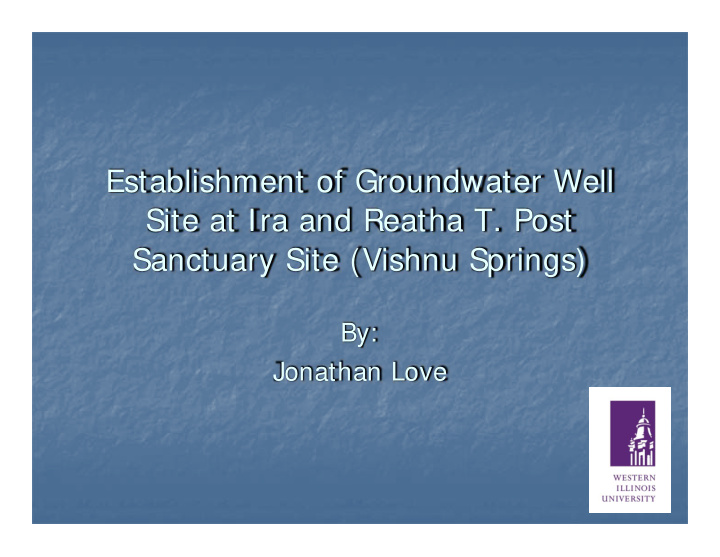



Establishment of Groundwater Well Site at Ira and Reatha T. Post Sanctuary Site (Vishnu Springs) By: Jonathan Love
Vishnu History Documented back to 1880 when a doctor promoted as medical spring Hotel built 1889 post office restaurant Windmill pumped water to hotel and surrounding houses Goldfish pond feed by spring Source: Marla Vizdal, WIU Alumni Assoc. webpage
Source: WIU Archives and Special Collections
(Photo by L. Dean, October, 2007)
(Photo by L. Dean, October, 2007)
Ira and Reatha T. Post Sanctuary Site • Well # 1 West of Hotel • Well # 2 Near Vishnu Spring • Well # 3 Uplands Prairie
Drilling Wells with Giddings
Drilling Wells with Giddings
Well Establishment Construction 5 foot screen at bottom Silica sand used as filter media Capped with bentonite clay Develop wells
Well # 1 (west of hotel) Total Depth 8.01 ft. Hit sandstone bedrock Bore sample taken
Bore Sample Textures Mostly sandy clay loam with small amount of silty clay and loamy sand at bottom Colors determined using Munsell color chart Varied from dark brown (3/2 7.5YR) to very dark grayish brown (3/2 10YR)
Well # 2 (near Vishnu Spring) Total Depth 7.61 ft. Created Artesian Well
Well # 3 (upland prairie) Total Depth 16.27 ft. Deepest Well Drilled
Water Levels Below Surface 8 8 8 8 8 8 8 8 8 8 0 0 0 8 0 0 0 8 / / / / / / 0 0 0 0 0 0 6 3 0 3 0 7 / / / / / / 8 5 2 9 1 2 3 6 1 2 2 4 1 2 / / / / / / / / / / 0 0 0 0 0 1 1 1 1 2 / / 9 9 1 1 1 1 1 1 1 1 1 1 depth below ground surface (feet) 3 2 1 0 Well #1 -1 -2 Well #2 -3 Well #3 -4 -5 -6 -7 -8
Slug Tests Performed slug-in and slug-out tests Use laptop computer and pressure transducer Slug volume 430 cm 3 3 minute tests: first 10 sec. measure every 0.1 sec. next 30 sec. measure every 1 sec. next 60 sec. measure every 2 sec. last 80 sec. measure every 4 sec. pressure transducer
Slug Test Well # 1 All slug tests analyzed with Bouwer-Rice Method using AQTESOLV program Average hydraulic conductivity (K) .0021 cm/sec
Slug Test Well # 2 .011 cm/sec Avg. (K)
Slug Test Well # 3 .0059 cm/sec Avg. (K)
Hydraulic Conductivity Summary Slug-in Slug-out Average Well # 1 0.002526 0.001635 0.0021 Well # 2 0.01176 0.009877 0.011 Well # 3 0.00698 0.004822 0.0059 Units measured in cm/sec.
Water Chemistry: Field Measurements Temperature Conductivity TDS DO ( S/cm) (C) pH (mg/L) % (mg/L) Well #1 15.7 6.74 602 358 55 5.05 Well #2 13.1 7.1 530 331 19.7 2.04 Well #3 17.3 6.6 444 254 40.2 3.7 Pond 12.1 7.09 530 331 15.1 1.7 Stream 13 7.72 530 331 90 9
Water Chemistry: Lab Analyses Location Date Na K Ca Mg HCO 3 CO 3 Cl SO 4 Vishnu Spring 1/31/2006 30 1.2 80 29 410 <2 <1 <1 Vishnu Spring 4/6/2006 31 0.64 83 27 420 <2 <1 1.3 Vishnu Well #2 11/6/2008 30 3.9 94 34 410 <2 1.3 <1 Vishnu Well #2 11/6/2008 30 3.7 86 31 410 <2 1.3 <1 Vishnu Well #2 11/6/2008 31 2.9 91 33 410 <2 1.3 <1 Vishnu Spring 8/1889 46 0 69 27 473 ---- 0.28 0 Concentrations in mg/L
Future Research Well locations using Total Station and GPS Locate second spring Ongoing measurements water levels water chemistry
Acknowledgements Dr. Roger Viadero, Director of the Institute for Environmental Studies for use of field equipment and purchasing chemistry analyses Robin Bauerly of the Institute for Environmental Studies for help with logistics and ordering materials Morris Wells for mowing path to well # 3, maintaining road, and unlocking gates Biology Dept. for use of Suburban to pull Giddings Drilling Machine
Recommend
More recommend